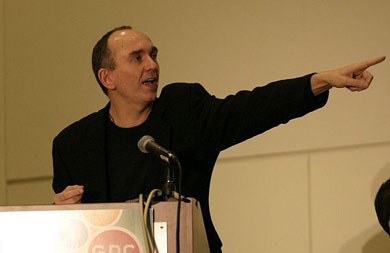The result was a very clever game idea called "Muse." Here, the idea is not to be Emily Dickinson, but rather to inspire her to create all of her greatest poems (she wrote over 1800 in the course of her lifetime.)
The idea is that you would 'build' the poems by stringing together symbols, and you would locate these symbols around Emily's environment. Emily herself wouldn't be controllable -- she'd have her own daily routine, such as visiting the post office or going for a stroll -- but you would be able to scramble around her daily chores in order for her to pass through interesting parts of town. Then, as she walked, objects in the world would contain symbols.
For example, Emily might walk near a willow tree. You'd click on it to have her walk up to it and be inspired. The willow tree would reveal several symbols for you: "Strength," "Blossom," "Tree," or "Wisdom" for example. Using up some of her energy, you'd grab the symbols, some for use right away and others for use later.
The game would play out in seasons, each represented by a different world: Spring, Summer, Fall, Winter, and a fifth (very abstract) world called "Fancy" which would basically be her own imagination. Unused symbols could be tucked away in Emily's fancy for later, which was important, because some symbols are easy to find in certain seasons and impossible to find in others. If you and a friend both had the game, you could trade symbols with each other wirelessly, like a poetic Pokemon.
Once Emily got home she'd sit down at her writing table to write. This would kick off a mini-game. Every one of her poems would have a puzzle-like 'recipe' that you'd have to 'solve' by connecting together the symbols you collected.
Once you 'solved' a poem, you'd be rewarded with an audio reading of the poem. You would also be treated to a custom 'video' to go along with that audio track. The video would show all the items that you collected the symbols from in order to create the poem. That way, no two videos would be alike, and each one would be like a catalog of Emily's personal experiences. The cool part is that you could share your videos with other players using the wireless function of the DS. After all, completed poem videos would almost be like walkthroughs telling you where you might find needed symbols. Clever!
That was Hocking's solution: he looked at the problem, tried to constrain it, then built his ideas off of that constraint. I have to give some serious kudos to Hocking, who actually tackled the problem with an intelligent, working game design. Certainly the crowd was impressed. On to the next contestant:

Molyneux steps up to the plate...
Peter Molyneux: Poetry In Motion
Unfortunately, it was clear that Molyneux didn't dedicate as much energy into his game design as Hocking did. Which is a shame, because it would've been great to see what Molyneux -- famous for his wide-open designs -- would come up with if he really applied himself. Then again, Molyneux himself admitted that he was dyslexic; so as it happens, the written word isn't exactly a medium that inspires him.
What he did instead was to map the idea of Dickinson's poetry into an abstract game concept that his team had already been working on. On the plus side, that meant that he actually had a working game demo to play around with. The Room was the name of his experiment. He talked about it more at length in his other presentation, so we'll post just a short summary here.
"What is poetry?" Molyneux asked. "It's just words creating visuals inside your mind." To that end his demo displayed a stunningly realistic room with interactive objects. For instance, you could reach up and spin the hands of the clock causing time to move forward, allowing you to play with concepts Dickinson explored in her poetry. Still, the link was tenuous at best, and the gameplay unclear. Molyneux explained during a short Q&A period that followed that players could recreate her poems or use those items and images to create poems of their own.
I wasn't exactly sold, although the demo featured some intriguing concepts. Read more about it in our writeup of Molyneux's keynote presentation.


